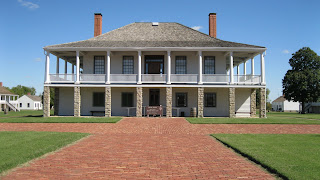
Probably one of the best purchases I ever made was to buy a Golden Age Passport from the National Park Service. It's free lifetime admission for myself and Laurie at our National Parks, Historic Sites, National Recreation Areas, etc. On this recent trip, we visited the Fort Scott National Historic Site in Fort Scott, KS.
The fort was established in 1842. It served as one of a line of forts stretching from Minnesota to Louisiana was intended to enforce the promise of a "permanent Indian frontier". Soldiers were to keep the peace between white settlers, native peoples such as the Osage, and Eastern Indian tribes that had been relocated west.
The first photo is of the Hospital. Built in 1843, it now houses a reconstructed ward, the Visitor Center and a bookstore.

This is the post commander's residence. In total, there are 11 major buildings on the site, plus 7 lesser outbuildings.
In the 1950's, a group of Fort Scott's citizens started a movement to refurbish and rebuild the fort as a historic site and tourist attraction. Buildings that were not part of the original fort were torn down and some historic buildings that had been demolished were rebuilt. In 1978, the fort became a National Historic Site.

This is Laurie's favorite building at the Fort... It's the Dragoon Stables. Built in 1843, this structure could house 80 horses with their feed, tack and hay. During the Civil War, it was used as a storehouse for over 1,000,000 rations.
Interestingly enough, no soldiers were ever killed in battle while stationed at Fort Scott.

This photo of the Bake House (1848) is a bit dark but this is where the food staple for the soldier's diet was baked. We were surprised to learn that the enlisted men took turns in baking the daily ration of bread.
For more information on Fort Scott, go to http://www.nps.gov/fosc/.

Another little known historic site is also found in Fort Scott, KS. This is the Fort Scott National Cemetery. Small in comparison to the rest of the National Cemeteries, this was one of the fourteen National Cemeteries so designated by President Lincoln and the US Congress on 11/15/1862.
Many Civil War casualties are interred here, to include 13 Confederate soldiers, 63 Colored troops and 16 Indian troops. There are also group graves for WWII flight crews whose individual bodies couldn't be identified.
For more information, go to http://www.cem.va.gov/pdf/ftscott.pdf.
No comments:
Post a Comment